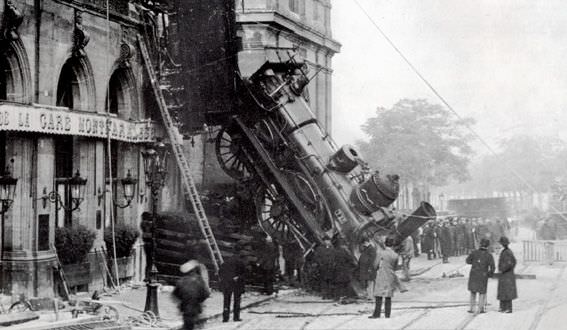
Montparnasse station, Paris 22 October 1895
It began in a nearly imperceptible manner. Interim contracts were not renewed, and then, little by little, layoffs were announced. They were modest at first, with five people here, seven more there and twelve somewhere else, until they started to really add up. During the month of April, more announcements caused even greater concern. Cartier declared it was reducing the hours of 500 of its 1000 employees working at the brand’s production site in La Chaux-de-Fonds. Franck MÜller let 100 people go according to the unions, while management put the figure at 93.
Even more serious, but with less media attention, was the luxury packaging maker, Setco, in La Chaux-de-Fonds, that closed its doors definitively with 47 jobs lost. More serious because we see, in this example, a sign of the difficulties that have migrated from the computer monitors to the cash in people’s wallets while the crisis was unfolding (essentially its passage from the virtual world of global finance to the real world—and how real it is—of the global economy). Retailers who saw the storm approaching tried last autumn to slow the flood of sell-in, which in spite of the bad weather continued to fill up their already overcrowded windows and storerooms.
When it was finally necessary to stop everything, order began to move along the entire supply chain, but it was primarily at the end of it, with the sup- pliers and specialists—what we call ‘annex’ branches—that the shock waves were the strongest. (In fact, these annex branches form the basis of the industry, without which nothing would be possible. Imagine a car without a bumper or a watch without a shock absorber.)
From one day to the next, suppliers saw their orders cut by a third, a half or even more. And, as if that was not bad enough, with stocks still abundant, the downward pressure on prices was becoming stronger with decreases of 10, 20 or 30 per cent. In the Jurassian arc region, which comprises a concentration of highly specialized small and medium watch-related companies, the ‘crisis’ hit like a lightning bolt, inflicting the most damage on the companies that, for the most part, had heavily borrowed money in previous years to invest in equipment and personnel. (More than 10,000 jobs over the last five years were created in the Swiss watch and watch-related sectors.)
Today, reductions in hours or partial unemployment are commonplace. Ateliers are running at 50 or even 70 per cent of their capacity, which in an instant means they have been transformed into dangerous overcapacity. ‘Hang on until 2010, lower your expectations while waiting for the recovery’ has become the leitmotiv of suppliers. Unfortunately, many of them don’t have the strength to hold on until then. On the other hand, some are already demonstrating remarkable resilience and, under these grey skies, are continu-ing research and development in new processes and technologies, honing their skills for better days.
Yet, without more employment of young people, who are understandably now demoralized, there is a great risk that, in a few years, the industry will find itself faced with the same gener-ational void that Swiss timekeeping experienced after the quartz crisis. It may very well find itself without dials and hands, without guillochage and polishing, without bracelets… and shock absorbers!
Source: Europa Star June-July 2009 Magazine Issue





